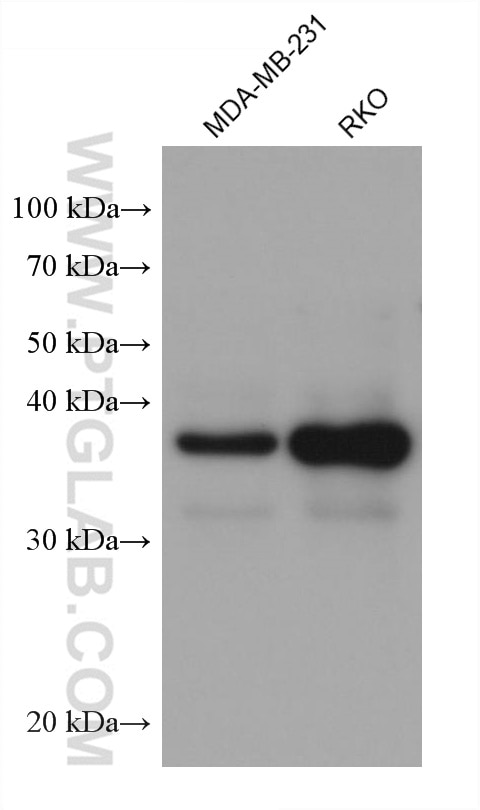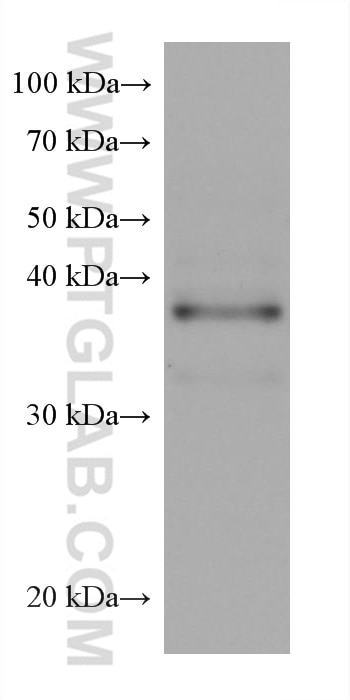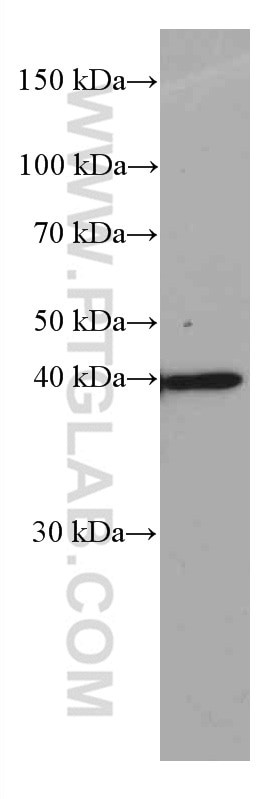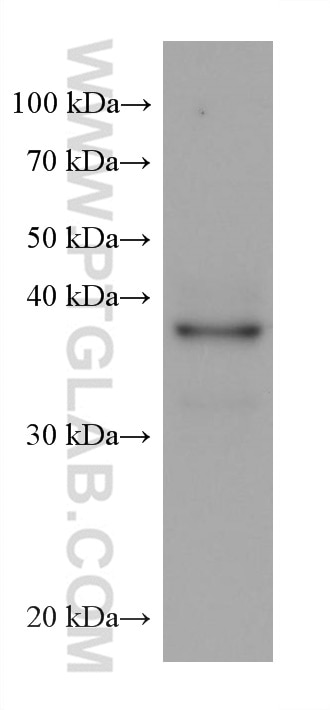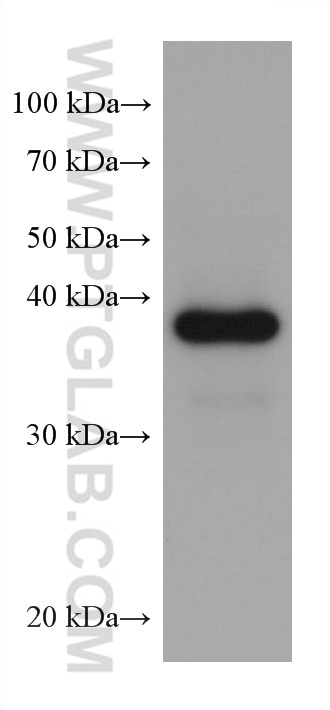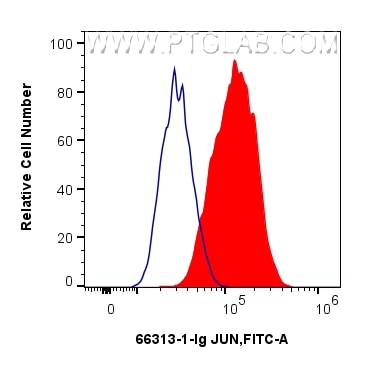JUN Monoklonaler Antikörper
JUN Monoklonal Antikörper für WB, ELISA
Wirt / Isotyp
Maus / IgG1
Getestete Reaktivität
human, Maus, Ratte
Anwendung
WB, ELISA
Konjugation
Unkonjugiert
CloneNo.
1G6B11
Kat-Nr. : 66313-1-Ig
Synonyme
Geprüfte Anwendungen
| Erfolgreiche Detektion in WB | MDA-MB-231-Zellen, HEK-293-Zellen, NIH/3T3-Zellen, ROS1728-Zellen |
| Erfolgreiche Detektion in FC (Intra) | NIH/3T3-Zellen |
Empfohlene Verdünnung
| Anwendung | Verdünnung |
|---|---|
| Western Blot (WB) | WB : 1:5000-1:50000 |
| Durchflusszytometrie (FC) (INTRA) | FC (INTRA) : 0.25 ug per 10^6 cells in a 100 µl suspension |
| It is recommended that this reagent should be titrated in each testing system to obtain optimal results. | |
| Sample-dependent, check data in validation data gallery | |
Veröffentlichte Anwendungen
| KD/KO | See 2 publications below |
| WB | See 28 publications below |
Produktinformation
66313-1-Ig bindet in WB, ELISA JUN und zeigt Reaktivität mit human, Maus, Ratten
| Getestete Reaktivität | human, Maus, Ratte |
| In Publikationen genannte Reaktivität | human, Maus, Ratte |
| Wirt / Isotyp | Maus / IgG1 |
| Klonalität | Monoklonal |
| Typ | Antikörper |
| Immunogen | JUN fusion protein Ag17639 |
| Vollständiger Name | jun oncogene |
| Berechnetes Molekulargewicht | 331 aa, 36 kDa |
| Beobachtetes Molekulargewicht | 39 kDa |
| GenBank-Zugangsnummer | BC068522 |
| Gene symbol | JUN |
| Gene ID (NCBI) | 3725 |
| Konjugation | Unkonjugiert |
| Form | Liquid |
| Reinigungsmethode | Protein-A-Reinigung |
| Lagerungspuffer | PBS with 0.02% sodium azide and 50% glycerol |
| Lagerungsbedingungen | Bei -20°C lagern. Nach dem Versand ein Jahr lang stabil Aliquotieren ist bei -20oC Lagerung nicht notwendig. 20ul Größen enthalten 0,1% BSA. |
Hintergrundinformationen
What is the molecular weight of JUN?
The molecular weight of JUN is approximately 39 kDa.
What is the cellular localization of JUN?
JUN expression can be located in the nucleus. However, ubiquitinated JUN colocalizes with lysosomal proteins (PMID: 15469925).
What is the function of JUN?
JUN is a basic leucine zipper (bZIP) transcription factor that recognizes and binds to a consensus heptamer motif of 5'-TGA[CG]TCA-3' in the enhancer region of target genes. JUN acts as either a homo- or heterodimer and binds to the DNA to regulate transcriptional activity, specifically promoting the activity of NR5A1 when phosphorylated by HIPK3, leading to increased steroidogenic gene expression upon the stimulation of the cAMP signaling pathway (PMID: 9732876).
What post-translational modifications is JUN subjected to?
JUN is acetylated at Lys-271 by EP300 (PMID: 11689449). JUN is phosphorylated by PLK3 following exposure to hypoxia or UV irradiation, which leads to increased DNA-binding activity (PMID: 27281822), and also by PAK2 at numerous threonine residues to promote cell proliferation and transformation (PMID: 21177766). JUN is also phosphorylated by DYRK2 at Ser-243, which primes it for subsequent further phosphorylation by GSK3B and reduces its ability to bind DNA (PMID: 22307329).
What is the role of JUN in disease?
Activation of JUN is linked with proliferation and angiogenesis in invasive breast cancers (PMID: 16733206).
Protokolle
| PRODUKTSPEZIFISCHE PROTOKOLLE | |
|---|---|
| WB protocol for JUN antibody 66313-1-Ig | Protokoll herunterladen |
| STANDARD-PROTOKOLLE | |
|---|---|
| Klicken Sie hier, um unsere Standardprotokolle anzuzeigen |
Publikationen
| Species | Application | Title |
|---|---|---|
Cell Biol Toxicol microRNA-149-5p mediates the PM2.5-induced inflammatory response by targeting TAB2 via MAPK and NF-κB signaling pathways in vivo and in vitro. | ||
Genomics Integrative epigenomic profiling reveal AP-1 is a key regulator in intrahepatich cholangiocarcinoma. | ||
Pharmacol Res CX-5461 is a potent immunosuppressant which inhibits T cell-mediated alloimmunity via p53-DUSP5. | ||
J Cell Physiol Lack of Mof reduces acute liver injury by enhancing transcriptional activation of Igf1. | ||
Front Pharmacol Azithromycin Attenuates Bleomycin-Induced Pulmonary Fibrosis Partly by Inhibiting the Expression of LOX and LOXL-2. |
